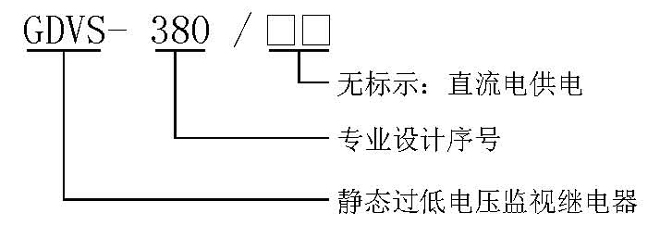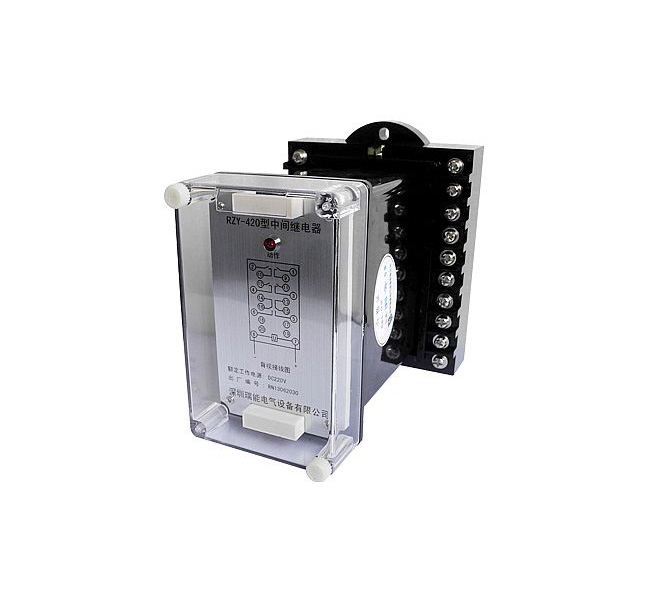1 Application range
This relay is used to judge the 380V system voltage is too high or too low, and delay the pulse signal to alarm.
2 Model definition

3 Working principle and main performance
3.1 Working principle
As long as there is one action for over-voltage GJ or low-voltage DJ, the delay oscillation circuit will be started, and the signal circuit XJ will act after 9S. After 10 minutes, if the over-voltage or low-voltage fault still exists, an alarm signal with an oscillation period of 10S and a pulse width of 1 second will be continuously issued until the fault is eliminated, and the signal circuit XJ returns; if the signal circuit XJ fails within 10 minutes after the action Eliminate, XJ returns.
3.2 Main performance
3.2.1 This relay is mainly composed of integrated circuits. Stable performance, high reliability, high accuracy of action value, small discrete value, wide setting range, fast action and return speed, good return coefficient, small load on the transformer, vibration resistance, anti-interference and high insulation level.
3.2.2 The setting is set by the dial switch on the relay panel, which is intuitive and convenient. The relay debugging is simple and convenient, without adjustment on site.
3.2.3 The relay has running and action indicator lights
4 Technical conditions
4.1 Environmental reference conditions
Environment temperature: 20±2℃
Relative humidity: 45%~75%
Atmospheric pressure: 86~106Kpa
4.2 Normal use conditions
Ambient temperature: -10℃~+50℃
Relative humidity of environment: not more than 90%
Atmospheric pressure: 80~110KPa
Limit temperature during storage and transportation: -25℃~+70℃
The altitude of the place of use: no more than 2500 meters
The surrounding medium of the use environment has no explosion hazard; it does not contain corrosive gas; the concentration of conductive dust contained should not reduce the insulation level below the allowable limit value.
Reliable power supply.
4.3 Rated parameters

4.4 Characteristic parameters
Low-voltage circuit Over-voltage circuit
Action time not more than 30mS not more than 25mS
Return time not more than 25mS not more than 30mS
Return coefficient not greater than 1.1 not less than 0.9
Operating range and level difference 200V~398V, level difference 2V 370V~469V, level difference 1V
4.5 Maximum power consumption:
AC voltage circuit: not more than 2.0VA under AC380V
Auxiliary power circuit: no more than 7W at DC220V
4.6 Maximum capacity of contacts:
Cut-off load capacity: DC 250V or less, τ=5ms, inductive load 50W, resistive load 150W;
AC below 250V, load 1200VA;
Allow long-term connection current: 5A.
4.7 AC voltage circuit overload capacity: continuous work under 1.2 times the rated voltage
4.8 Insulation resistance: Use an open-circuit voltage 500V megger to measure the insulation resistance between the exposed non-charged metal parts or shells of the relays connected to each conductive terminal and should not be less than 10MΩ.
4.9 Insulation withstand voltage: each lead-out terminal to the housing locking screw can withstand a power frequency voltage of 2000V, and the same group of contacts can withstand a power frequency voltage of 1000V, which lasts for one minute without breakdown.
4.10 Anti-interference performance: meet the national GB6162-85 "Electrical Interference Test of Static Relays and Protection Devices" standard.
4.11 Electrical life: In the DC250V circuit, cut off the current τ=5ms, 50W, more than 104 times.
4.12 Mechanical life: The contact is 3 million times in no-load state.
5 Structure type (see the relay structure size diagram for details)
5.1 Embedded board rear wiring structure AK11, AP11 and protruding board front wiring AQ11 rear view wiring diagram (subject to company product samples)
6 Use
6.1 Before energizing the relay, confirm whether the voltage level and current value of the connected relay are consistent with the actual parameters, otherwise the relay may be damaged; check whether the relay is damaged during transportation and storage, and the relay screw fasteners should not be loose; There are damaged parts, please contact us to replace them.
6.2 According to the formula on the panel of the relay, use the dial switch to set the value.
* When the overvoltage component is 370V~469V, the setting formula: U = (10□+□+370)V
* When the low voltage component is 200V~398V, the setting formula: U = (20□+2□+200)V
7 Ordering instructions
When ordering, please specify the relay model, specification, quantity, structure, auxiliary power supply voltage, AC rated voltage and other requirements.











